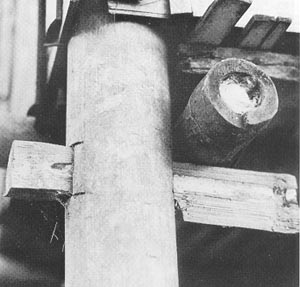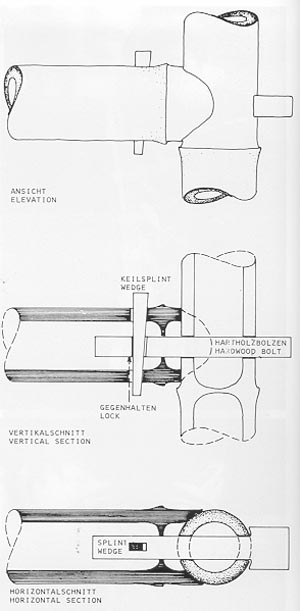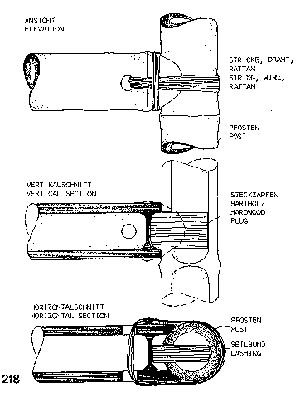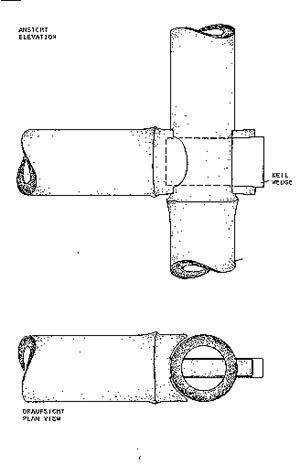
Plugin console
Plugin connections: Carpenterlike connections with mortise and tenon are seldom used in bamboo structures. On the other hand plugin elements like bolts or consoles you find very often. Additional lashing or wedging keeps things in place.
A disadvantage of these connections is that you donīt use the whole diameter for power transmission. Also you must pay attention that the holes are not too close to the end of the canes. Otherwise the plug may break out.
The use of nails may split the bamboo particular old and dry canes. Pre-drilling is a method to prevent splitting. There are two bamboo species which can be nailed: Guadua angustifolia and Chusquea.

Bolt structure
Plugin connection: This is a type of connection for greater diameters with a hardwood bolt and wedge. Five holes, the bolt and the wegde - a more extravagant connection. If the bolt is conical, the connection is save in all directions.

Connection with inner plug
Connection with inner plug and a horizontal drill-hole to fix the connection with a lashing tie. If the lashing is tight and the plug fits quite good into the opening, both plug and lashing can do the power transition. But even if not, this connecting method can be very durable at less force. The inner plug prevents the beam from slipping down the post and the lashing is against unplugging.

Rope connection fixed with bolt
Rope connection fixed with bolt. The bolt keeps the conncetion in place even if the rope or cord lenghtens .

Complicate joint
Joint with two connections. Again a combination of bolts and lashing to connect the canes.

Interlocking connection with wedge
Interlocking connection with a wedge. With the wedge driven into the opening, the strips of the horizontal beam are pressed into the hole and fix the beam. If the wegde shrinks, the beam can be easily pulled out of the opening. So additional arrangements like lashing or bolts are necessary for a save connection.

Connection with steel clamp
Connection with a steel tension clamp. Leaving the low-tech sector, with the use of steel elements a lot more connections become possible. Avoid connections which produce great forces vertical to the cane axis. They can destroy the bamboo cane.

Connection with steel tube and bolts
Modern connection by Shoei Yoh in 1989. For his bamboo roofs in Fukuoka, Shoei Yoh used a steel tube put into the bamboo and which is connected to the cane with bolts. The steel tube is strong enough to withstand the pressure of the tightened bolts. In addition there are two bolts in vertikal direction. For the connection to the knot a steel bar is welded into the tube and again it is screwed to the knot. Because of the numerous bolts the connection is also suitable for greater loads. The result is a very technical but strangely overstyled looking connection.

Connection with steel wire
Modern connection by Renzo Piano Building Workshop in 1997. The canes are connected to a special designed steel element via binding wire. Instead of a bolt driven through bar and cane, a wire is tied through the holes and tied around the bamboo. A fine artwork but because of the fine wire seemingly only for small forces.